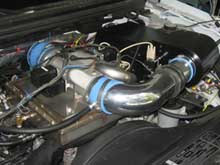Ray Bushnell and company co-founder Bob Reid say they're close to perfecting Vapor Fuel Technologies' fuel delivery system, a new way for optimally mixing fuel and air before it explodes in a combustion chamber.
Vapor Fuel's product faces daunting hurdles, not least the difficulty of adding devices to today's computer-controlled gas engines, an ambitious 2009 production schedule and the potential for demand to plummet if gas prices return to earth.
But the company has five patents in hand and four pending. And a certified testing lab last year in Southern California documented a 30 percent mileage increase in a Ford F-150 with the Vapor Fuel system. "Timing is everything," said Joe Jones, the California lab's research director. "And certainly their timing is right."
Today's engines are far more complex, notes Jack Friedman, general manager of Unichip of North America in Hillsboro, which is developing an add-on to sync Vapor Fuel's device with manufacturers' on-board engine computers.
Computers monitor everything from air temperatures to throttle position to atmospheric pressure fast enough to regulate an engine turning up to 100 times a second. Unichip's software includes 94,000 data points for engine timing alone.
The company started out by heating gasoline enough to vaporize it before it entered the piston chamber -- an idea inspired by one of Reid's acquaintances, who ran a car off a 6-foot-long tank of vaporized fuel.
That causes it to expand ( the same principle a hot air balloon relies on) and fill up more space with less air. Combined with vaporized gasoline, they could keep the air-fuel ratio the same, dodging the pollution problem.
The heated mixture had another benefit, Bushnell and Dean said. Its "flame speed" -- how fast it burned -- and its explosive potential were higher than normal. That meant much more of it could be exploded when the piston was at its optimum position. And that meant they could use less gasoline without sacrificing power.
The system pulls heat from the radiator system to heat the fuel, and waste heat from the exhaust manifold to heat the air.
Vapor Fuels hopes to get CARB certification later this summer after Unichip completes its work. Meantime, they're talking with investors and potential buyers, with plans to start sales by the third quarter of 2009. Its first target market: North America's 102 million light trucks and sport utility vehicles.

